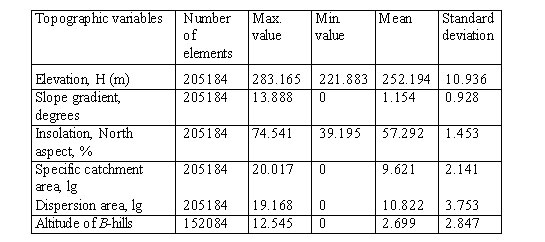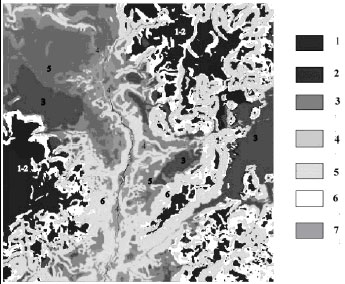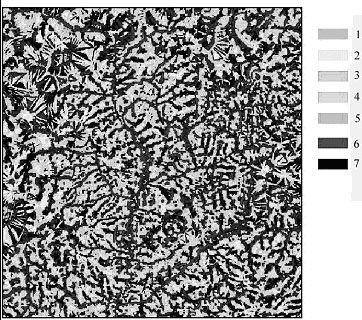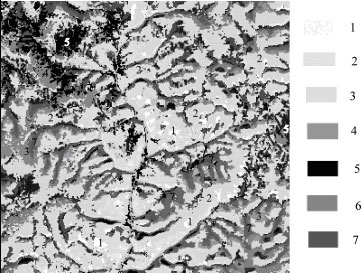Sustainable nature management requires prediction of geosystems functioning. To model and predict processes of matter and energy transfer we face the need to describe in adequate way landform types in connection with redistribution of gravitation and insolation which are believed to be principal driving forces of geosystem processes. In this connection fundamental challenge facing theory of geosystem is to describe potential geophysical differentiation of landscape units. The objectives of the research are as follows: 1. Selection and grouping of topographic variables which enable to determine redistribution of gravitation and insolation fields by relief; 2. Evaluation of spatial distribution of topographic variables by means of digital elevation model (DEM) composed for the territory of interest; 3. Development of objective geosystem classification for the low hierarchical level. The classification should take into account identification of landscape units based on gradients of governing fields as well as fields-induced flows; 4. Determination of hierarchy of low order catchment geosystems and study of feedback between structure and hydrological-hydrochemical functioning of geosystems.
System of topographic variables. Application of GIS forces to study relief in terms of topographic variables (TV) and generalized characteristics like gradient and laplasian. Review of how to apply topographic variables to various tasks see in numerous publications [1, 2, 3, 8 and others]. However, to identify geosystem boundaries as well as to describe landscape functioning and energetic characteristic of units the researcher is confronted with the need to perform spatial analysis of system of topographic variables. The latter should enable to get insight into concrete mechanisms of redistribution of geophysical properties by relief. Questions of the justification of methods how to select and calculate TV are viewed by P.A. Shary [5, 6]. A set of TV values includes: 1) elevation, 2) local TV involving first order derivatives, 3) local TV expressed in terms of first and second order derivatives including full system of surface curvatures, 4) curvatures of contours and flow lines not included in the full set of curvatures, 5) three well-known global TV, namely specific catchment area, specific dispersion area as well as solar radiation dose.
To calculate and visualize TV we applied GIS "ECO" worked out by P.A. Shary. Study objects were chosen in the southern section of Centralno-Lesnoy State Biosphere Reserve (CLSBR) located in Tver region. Some statistical characteristics of DEM for the territory see in table 1. DEM is base on topographical map, scale 1:10000.
Table 1. Statistical characteristics of some topographic variables.

The best visual representation of relief is the map of slope aspect which characterizes spatial pattern of north and south aspect slopes and shows redistrubution of solar radiation and heat. Slope gradient is a quantitative measure for maximum rate of decrease of elevation in gravitation field. Surface migration is affected by tangential component of gravity which is proportional to gradient factor, not gradient itself. Description of landforms aimed at revealing transfer mechanisms can be realized using surface curvature value.
The first mechanism of accumulation is explained by convergence or divergence of surface flows. It was proved in this connection [4] that divergence of flow lines equals plan curvature of the Earth surface kp which in turn equals contours curvature with corresponding sign. J. Krcho (cited from [5]) introduced horizontal curvature kh, signs of kp and kh being the same. That is why the first mechanism of accumulation can be represented by more convenient map of kh. The map of horizontal curvature kh can be interpreted as a map of spurs of hills. The notion of spurs and terraces were related to notions of horizontal and vertical curvatures by soil scientist A.R. Aandahl (cited from [4]). On concave spurs (kh<0) flow lines (as well as flows of other migrants) form convergence areas; on convex spurs divergence is inherent. Accumulation of surface flows of substance by means of convergence on concave spurs is referred to as the first mechanism of accumulation.
The second mechanism of accumulation is explained by relative deceleration of flows. Derivative of gradient factor by the length of flow line, i.e. vertical curvature kv, describes quantitatively the second mechanism of accumulation. The map of vertical curvature values can be interpreted as terrace-like concave (kv<0), or convex (kv>0) scarps. Concave scarps force migrants flows to be slowed down while convex ones - to be accelerated.
Ridge-like landforms act as watersheds being oriented in gravitation field with ability to divide water flows. In other cases ridges are either referred to as edges or have no particular term. The map of spurs reveal the main watershed of hills from where spurs diverge. The map of terrace-like scarps depicts asymmetry of hills.
Connection between principal mechanisms of accumulation and curvature provides opportunity to compose the map of areas of relative accumulation and outflow of substance. We treat areas where both mechanisms of accumulation operate simultaneously as zones of relative accumulation. Intersections of concave spurs and concave terraces are included into this category. In zones of relative outflow neither of these mechanisms operates, migrants flows being divergent and subject to relative acceleration. Morphometric formalization of the zones mentioned above is in proper concordance with the concept of landscapes geochemistry conjugation of elementary units (after B.B.Polynov, M.A.Glazovskaya, A.I.Perelman).
In general, effect of landforms on flows is interpreted as topographical prerequisites for corresponding processes. For example, rate of flow increases as slope gradient increases only under similar prescriptions as follows: constant effective friction along the slope, affected by lithology, plant cover, components of migrants etc.
Specific catchment area (SCA) is the TV of crucial importance for study of hydrological processes. SCA evaluates the area from which dissolved substance may be collected from the slopes to each surface elementary unit. Few other indices include SCA as a constituent like topographical index (TI), stream intensity index (SI), erosion index [3, 8]. Calculation of SCA usually is accompanied by evaluation of B-depressions with horizontal water surface which tend to be filled with water up to the maximum possible depth, up to the lowest possible effluent level.
The map of SCA shows permanent, short-term, ephemeral stream courses, and also potential streams indicated by sites of groundwater emergence. The map allows us to identify easily watersheds and talwegs as well as to determine catchment rank order according to Horton-Strahler concept.
Dispersion area evaluates the area to which water or particulate matter will spread over from each elementary unit. To calculate dispersion area it is enough to invest matrix of elevations (i.e. to replace z by (-z)) and to apply the same algorithm as for SCA. The map of dispersion area is used for quantitative identification of B-hills.
TV systems "Earth surface - solar radiation" turned out to be very useful for the analysis of insolation regimes (thermoregimes) of the surface.
Light level of slopes is a flux of solar radiation in percent (ranging from 0 to 100 %) from maximum possible radiation directed normally to landsurface. Light level depends on the Sun position which is described by two angles: azimuth and declination from the horizon. Light level characterizes instantaneous action of solar radiation.
Solar radiation dose over the certain period (e.g. daily, annual) is more effective to assess insolation and thermoregime of slopes. To obtain this TV one should integrate light level for the chosen period. Calculation formulas are composed via generalization of astronomical climate theory taking relief into account. Solar radiation dose is independent on concrete azimuth value and declination of the Sun (as a result of integration). However, it is necessary to consider site latitude and day in a year which affect trajectory of the Sun movement over the sky. Algorithms of direct solar radiation dose are realized in a series of publications [9].
Accuracy and correctness of formalization procedures depend directly on scale of research, quality of primary maps and DEM. We argue that scale 1:10000 is relevant for solving the problems under consideration in plain boreal landscapes.
Method of landsurface classification. Results of TV calculations are tabulated with surface elements (pixels of DEM) as rows and TV describing state of the element as columns. Variables applied to describe the same surface element have various physical significance, being not comparable. In addition matrix will be affected by changing measurements scales. Therefore, data matrix is standardized, means being equal to zero, variances being the same.
Thus vectors-rows in data matrix characterize a set of relief surface elements. The less is the difference between values of variables for a couple of objects, the closer are two vectors geometrically in space of variables. We used FRACDIM software worked out by G.M. Aleshchenko and Yu.G. Puzachenko [4] to classify relief based on TV matrix. The software uses Euclidean distance to measure distance between vectors-objects.
Correct choice and calculation of function of distance measure means that linkage matrix for objects is composed. Then automatic classification of objects reduces to diagonalization of the linkage matrix. The problem of automatic classification have two peculiar features that promoted its active application to spatial tasks. First, the problem of automatic classification could be understood as a geometrical task or identification of points clusters in certain space. It enables to solve the classifications problem of spatially distributed objects (e.g. relief surface elements, remote data etc.). Second, although a number of objects in the matrix of geographical data is big (up to hundreds of thousands), relevant recurrent algorithms are available, which make calculations with the only row of the matrix at each step.
Physical significance of each TV is obvious and described above. Since redistribution of energy and matter in biological and hydrological circles in gravitation field is a main control for geosystem structure at the low hierarchical level, we distinguish three groups of TV:
TV used to describe factors of redistribution of solar (as well as heat) energy: direct solar radiation dose (daily, annual); aspect and light level of slopes; slope gradient, elevation.
TV used to describe factors of water distribution and accumulation under the control of gravity: specific catchment area and specific dispersion area; depth of B-depressions and altitude of B-hills; slope gradient.
TV used to describe factors of matter redistribution under the control of gravity: horizontal, vertical and mean curvature; slope gradient; elevation.
Since we need to consider as few independent variables of landscape units differentiation as possible, only three significant TV from each group were chosen
Results and discussion. Figure 1 shows results of step-by-step dichotomic grouping of surface elements based on variables describing redistribution of solar and heat energy.
Consequent steps of classification procedure are columns of images, weight of variables being changed in rows. At the first step two most general groups are identified. Groups are distinguished according to slope aspect: warmer slopes facing south, colder north-facing slopes. At the following steps consequent division of both groups is performed resulting in identification of plots with high light level and then with various slope gradients. Initial classification is in poor agreements with landscape pattern revealed during field survey. On the one hand, index of slope gradient seem to overweigh other variables. This is not true for flat area. On the other hand, properties of overhumidificated units turned out to be underestimated which is manifested in failure in identification of mire expanses. Therefore, following classification required multiplying weighting coefficients by factor 1.6 concerning slope gradient as index of drainage conditions. As a result classification output changed significantly. Already at the first step class of well-drained slopes are distinguished from flat swamped areas. At the next step division takes into account slope aspect and light level.
Verification of the results obtained by means of discriminant analysis showed evidence that according to F-test classes differ significantly at all levels. At the first step classification procedure is governed by slope gradients (SLOPE, F=363288; EXPO, F=71.; LIGHT, F=697.). At the following steps contribution of slope aspect and light level increases (at the fifth level SLOPE, F=144273.; EXPO, F=34264.; LIGHT, F=62694). At all the levels classification matrix seem to be almost diagonal, inaccuracy being manifested only at the fifth level and lower ones. For all the other levels percent of correct classification exceed 83%, being 90% in average at the fifth level.
Consequent classification of relief elements based on variables of flow distribution starts with separation of permanent currents (the Mezha river) from its catchment area. At the next steps plots with higher SCA are delineated, followed by identification of elements with different slope gradients and, finally, different elevation levels. Verification by means of discriminant analysis showed that according to F-test at all the levels classes differ significantly (p=0.00). At the first step classes are distinguished by SCA (F=878640.8), at the third level - by slope gradient (SLOPE, F=100101.0),. At the last level F-test value increases for elevation (HEIGHT, F=5844.4). The most correct classification is obtained up to the fifth dichotomic level, probability of correctness being more than 96%.
Map of relief classification related to drainage conditions (Fig. 1) demonstrate leading role of swamping process. Dark colors related to various types of bogs and swamped areas dominate. The list of well-manifested landscape units include vast mire expanses located in depressions, big mire expanses on flat tops of hills and ridges, mesotrophic bogs on terrace-like scarps, hanging mesotrophic bogs on gentle slopes as well as stream valleys and wide flow channels with bogs. Light plots mark well-drained gentle slopes of morainic hills and ridges, white ones - well-drained slopes with maximum gradients.

Fig. 1. Classification of relief structure based on variables of flow distribution.
1 - plane surfaces of moraine ridges and hills with bogs; 2 - plane and sloping wet surfaces of ridges and hills; 3 - bog landscapes (oligotrophic, mesotrophic, swamps); 4 - border zones of bogs and swamp, concave slopes, swamp valleys; 5 - plane faintly drained slopes and surfaces of terraces (low surfaces); 6 - well-drained slopes of moraine ridges and hills; 7 - valley of Mezha river.
Results of classification describing mechanisms of accumulation referred to as landscape-geochemistry classification see on Fig. 2. Light plots correspond to eluvial landscapes, black ones to superaquatic landscapes. Gray and dark plots depict transitional landscape units: transeluvial, eluvial-accumulative, transaccumulative ones etc.

Fig.2. Classification of landscape-geochemistry conditions.
1 - autonomous eluvial landscapes; 2 - eluvial landscapes; 3 - transeluvial landscapes; 4 - eluvial-accumulative; 5 - transeluvial-accumulative landscapes; 6 - accumulative landscapes; 7 - superaquatic-accumulative landscapes.
Generalized map of natural territorial complexes (NTC) classification based on DEM morphometric analysis is represented on Fig. 3. Grouping took into consideration indices of distribution of geophysical fields with weighting coefficients obtained earlier. The map demonstrates great importance of swamping process being typical for watershed area with poorly-developed drainage network.
The findings obtained suggest that classes may be identified in various ways. In this connection landscape approach has crucial importance because it is the very instrument that enables to reveal factors of landscape differentiation in particular geographical conditions. Model of factors of differentiated is urgently needed. It could be semi-empirical, for example in the form of regression equation as it is realized in [9]. In general a set of morphometric indices together with weighting coefficients should be calculated during identification of parameters on the basis of field records and remote data.
On the other hand model provides opportunity to predict landscape pattern changes under the impact of melioration, climate changes, neotectonic processes, down-cutting etc. To realize these opportunities one should change weights of factors in the model in concordance with observed trends.

Fig. 3. Classification of natural territorial complexes (NTC) based on morphometric variables of distribution of gravitation fields and insolation
1 - NTC of slopes of moraine ridges and hills with southern aspect; the warmest and well-drained ones, transeluvial; 2 - NTC of plane surfaces of hills summits and terraces, warm, well drained, eluvial; 3 - NTC of slopes of moraine hills with northern aspect; temperately warm and drained, transeluvial; 4 - NTC of slopes with northern aspect; temperately cold and poorly drained, transeluvial; 5 - NTC of plane surfaces of bogs in linear depressions and basins, cold, wet, transaccumulative, superaqual; 6 -NTC of plain surfaces of moraine hills and terraces with bogs and peripheral parts of oligotrophic bogs, cold, wet, transaccumulative, superaqual; 7 - NTC of Mezha river valley with swamps, temperately cold, superaqual and transaccumulative.
Verification of the results of formalized procedures is performed using data of study on transects and key sample plots. To illustrate the results let us give the example of correlation between indices of NTC structure and TV. For example, between depth of Histic horizon related to humidity of soils and some TV on large data set forces the linkage to be non-significant. However, within the particular classes linear correlation between Histic horizon depth and values of kh, kv and H is obvious with coefficient of correlation exceeding 0.9.
Structure and functioning of low-order geosystems in boreal environment are determined for the most part by water runoff.
We applied values of horizontal curvature, specific catchment area and dispersion area to delineation of catchment geosystems of different orders in concordance with Strahler-Philosofov scheme. In reality, drainage divides of any order correspond to local minimum of SCA value as well as to that of kp. Talwegs coincide with local maximum of dispersion area (local minimum of SCA) and local minimum of kp (negative value). We distinguish criteria of geosystem orders as follows.
Geosystems change their order if two catchments (talwegs) of the same order converge. If converging catchments have differ in order the order of large catchment remains the same.
First-order catchment geosystems are devoid of well-manifested thalweg. Poorly-developed swampy hollows are typical. Second-order geosystems have talweg with ephemeral stream during the flood. Third-order catchments and, in particular, fourth-order ones have more or less well-developed river channel incised into bedrock. Fifth-order geosystem (the upper basin of the Mezha river) have both valley and river bed incised into alluvial deposits.
We identified catchment geosystems of five orders omitting elementary landscape units. Geosystem of the Mezha catchment has the maximum fifth order near village Fedorovskoye. (Note that according to hydrological classification the Mezha is the first-order river). Statistical parameters of catchments identified see in table 2.
Table 2. Basic statistical parameters of catchment geosystems

Dependence of mean catchment area (Y) on its order (X) is expressed by equation Y=b0*X**b1 with parameters b0=0.419665, b1=2.526742; R=0.99977. Data on first-order geosystems are approximated by log-normal distribution.
Data shown in table 2 show direct linkage between flow and average catchment area as well as catchment rank order. Due to the lack of discharge records statistically significant linkage can be hardly obtained. Note that linkage between discharge and catchment rank order follows evident non-linear pattern. Unit discharge value in June varies from 12 l/sec•km2 in second-order geosystems to 8-9 l/sec•km2 in fourth-order geosystems and reaching minimum values 3-4 l/sec•km2 in fifth-order ones.
We applied combined analysis of DEM and space image Landsat 7 to compose map of plant cover and landscape map of the study area. Data analysis enables to identify 3 main types of geosystems: 1. Low order geosystems with nemoral spruce forests occur in dissected areas and supply currents with ground alimentation and high ion contents with rapid debit. Discharge is less then 0.01 l/sec; 2. Low order catchment geosystems with prevalence of boreal spruce forests affected by windfalls, partially swamped. Currents with bog alimentation prevail (low ion content, acid reaction) with mean discharge 10 l/sec and relatively high unit discharge; 3. Geosystems of high fifth order with combination of all relief types and plant cover types. Water stream has mixed alimentation. During waterflood decrease bog acid waters prevail. During drought period bog flow decreases dramatically; alimentation is provided by highly mineralized soil-ground waters. Discharge varies from 200 l/sec to 1-5 l/sec.
Conclusion. The research enabled to develop and realize theoretical method of elementary units identification. It is based on analysis of morphometric attributes of relief that control redistribution of geophysical fields.
Solar radiation dose, light level, slope gradient, slope aspect proved to be significant morphometric attributes that affect distribution of insolation field. List of TV being useful to characterize water flow includes specific catchment area, slope gradient and elevation. To characterize mechanisms of landscape-geochemical transfer list of relevant TV must in clued horizontal and vertical curvature of surface. Verification of the results shows evidence that TV are applicable to correct prediction of soil cover properties as well as prediction of properties of geosystem as a whole.
Parameters of hydrological functioning are densely related to structure. Dependence of mean catchment area (Y) on its order (X) is expressed by equation Y=b0Xb1 with parameters b0=0.419665, b1=2.526742; R=0.99977. Moment discharge and unit discharge depends also on the order of geosystem, discharge being increased, unit discharge being decreased at each next level.
Procedure of geosystem units classification in terms of topographic variables characterizing redistribution of geophysical fields requires composing models of factors of landscape differentiation for the certain physical-geographical conditions. On the other hand, we obtain obvious perspectives for modeling landscape pattern development under external impacts.
The research was supported by Russian Foundation for Basic Research (Grant 02-05-65174).
Literatura
Burrough P.A, Wilson J.P, Pauline F, Hansen A.J. Fuzzy k-means classification of topo-climatic data as an aid to forest mapping // Landscape Ecology. 2001. Vol. 16.
Evans I.S. General geomorphometry //Geomorphological Techniques. 1981.
Florinsky I.V. Combined analysis of digital terrain models and remotely sensed data in landscape investigation // Progress in Physical gGography. 1998. Vol. 22, № 1.
Puzachenko Yu.G., Aleshchenko G.M., Molchanov G.S. Multidimensional analysis of aerial photos applied to landscape pattern studies //Izvestia RAN (Proceedings of Russian Academy of Sciences), Geographical Series. 1999. No 2. P. 80-90. (In Russian)
Shary P.A. Topographical method of second order derivatives //Geometry of the Landsurface structures. - Poushchino: PNC, 1991. - P. 28-58. (In Russian)
Shary P.A. Land surface in gravity points classification by a complete system of curvatures // Mathematical Geology 1995. Vol. 27. No 3.
Syssouev V.V. Structure-forming geosystem processes: characteristic scales and modeling // Vestnik Moskovskogo Universiteta (Proceedings of Moscow University), Geographical Series. 2002. No 1. (In Russian)
Terrain Analysis: Principles and Applications / Edited by J. P. Wilson, J. C. Gallant. London, 2000.
Zaitsev M.L., Ivanov A.N., Petrushina M.N., Fedin A.V. Factors of development, structure and finctioning of Sub-Mediterranean landscapes. //Landscape school of Moscow University: traditions, achievements, perspectives. Moscow, 1999. (In Russian)